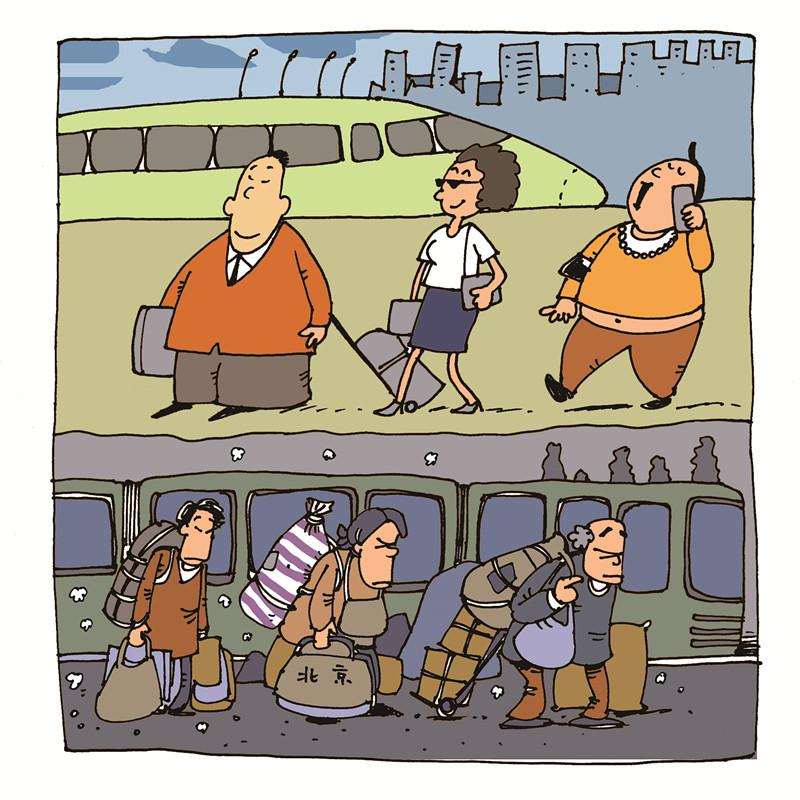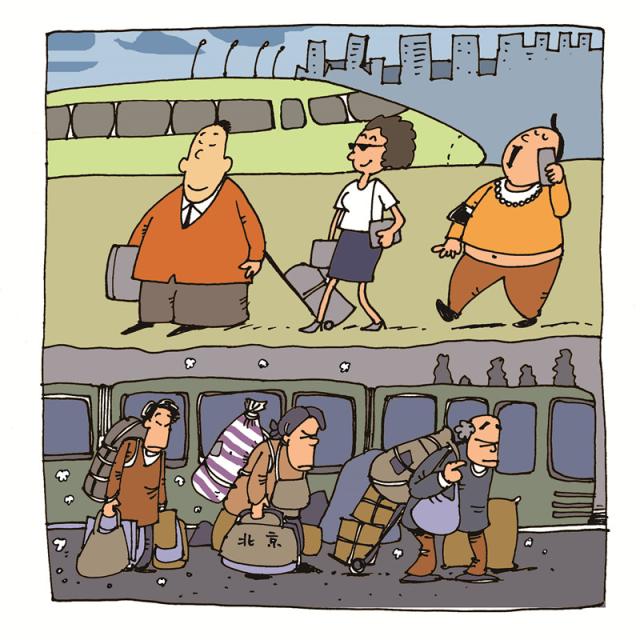
 Old Version
Old Version

Train travel is one of the joys of spending time in China. Not only do you roll through ever-changing scenery, but you get to meet all walks of life. Or at least you used to. The introduction of the high speed network has brought about its own class division, with the older, slower trains and stations for poorer residents and migrants, and the newer, faster services for the well wheely-suitcased. Stations and trains may connect the same cities, but they feel like they serve different countries.
In many cities the stations for the trains now considered slow are separate to those for the high-speed gaotie services that cruise at over 300 kilometers per hour. The older stations with their Soviet design hints maintain their central locations while gaotie services pause at new stations out of town, typically at airport distances from the center. Slow train stations are surrounded by bus stops, high-speed stations by expansive car ramps to departure and arrival levels, car parks and taxi ranks.
Arriving at the old stations you’re met with huge crowds and people sleeping on the ground among large bundles of luggage. This is nothing new, but the investment in the new network seems to have been absolute, with all money diverted away from such things as maintenance of the older network, not that anyone of importance is going to see that as they’ll be making their way to shiny new stations with business class lounges, plastic palm trees and multiple branches of Starbucks. Where old stations still maintain a lead on their new upstarts are the offerings of pot noodles. Boiling water dispensers in stations and trains alike are perhaps the only universal for new and old networks.
Once on board a gaotie, the atmosphere is palpably different, thinner even with barely any cigarette smoke. High-speed travellers are transfixed with an array of screens they’ve brought on board and keep fully charged via the sockets by each seat. The countryside and its inhabitants outside are rendered irrelevant as the trains zip between cities. The carriages are quieter (some people even use earphones when watching films on their phones) and more serious. Passengers tend not to talk to each other, partly because seats are arranged like on a plane rather than facing each other across a table as they are on the slow trains.
This doesn’t mean I can get away with working on my own screen, but I have noticed that in general only the people next to me strike up a conversation, rather than passengers from several carriages away who’ve got wind there’s a foreigner on board and rush to ask about my salary, marital status and chopstick abilities.
Gone are the slow train group conversations about China, the places we’re passing, what I should eat at the destination, replaced with equally earnest one-to-one discussions on property prices, wine as an investment, moving money abroad – from common, shared topics to issues concerning the individual who strikes up the chat.
As with the passengers, the staff are similarly different, though both teams abide by the principle that it is a train being moved around the country and any humans on it are an afterthought, unless they want to buy things.
Dressed as airline cabin crew with equally smug hats, gaotie staff sport earpieces and an absolute lack of any tolerance towards such passenger transgressions as bag straps dangling from luggage racks or people hanging their jackets on the coat hooks provided. On a recent trip back from Shenzhen, the staff even took each child in turn to the vestibule area to measure them against the height markers that determine what kind of ticket they require. Thankfully they all passed and were allowed to return to their parents.
On the slow trains things are a little more relaxed and when trains get really busy, staff tend not to notice chain smoking or passenger arms dangling from luggage racks. Instead there’s a greater emphasis on sales-as-entertainment, with product demonstrations sometimes getting a whole carriage to gather round and pass judgement on both product and practitioner.
Once on a slow train to Shanhaiguan a salesman brought custom-built mannequin heads that slotted onto the backs of seat at the neck so he could show off the multiple hairstyles that could be achieved with his cutting edge hair ties. This kept us entertained for a whole hour, though I don’t remember anyone actually buying any.
Fast-train staff give short demonstrations for aspirational products such as freeze-dried blueberries, but mainly stick to pushing trolleys of controversially-priced meal trays and imported beer and snacks that make journeys even more alienated from the landscapes they’re bisecting.
I may miss taking the slow trains from their city center stations with their slower-changing scenery, entertainment and potential for the unexpected, and I may be aware that I’m cutting myself off ever more from much of the population, but I keep booking those gaotie trains. I even choose destinations based on the high-speed network, because getting there fast seems so crucial when booking. Just not crucial enough to make me deal with the country’s airports.